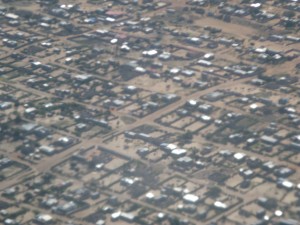Noe Mendelle, Director of SDI, was asked to make a documentary about a housing research project led by Edinburgh University and Royal Danish Academy of Fine Arts. Here are some reflections on her experience.
The Cement City
 The Home Space project is based on a 20 year research on how the suburbs and land around Maputo is changing. The cement city aka Maputo city centre is like a fungus growing at the expense of the land around it. The suburbs around the city are mainly self-built dwellings, first out of bamboo now slowly being replaced by cement blocks and corrugated iron. At a time when land had no value, plots were given to poor people mainly dislocated during the war, to cultivate. Over the years families grew and so did poverty and plots got divided and sold off, often sacrificing the allotments where women grew the household food.
The Home Space project is based on a 20 year research on how the suburbs and land around Maputo is changing. The cement city aka Maputo city centre is like a fungus growing at the expense of the land around it. The suburbs around the city are mainly self-built dwellings, first out of bamboo now slowly being replaced by cement blocks and corrugated iron. At a time when land had no value, plots were given to poor people mainly dislocated during the war, to cultivate. Over the years families grew and so did poverty and plots got divided and sold off, often sacrificing the allotments where women grew the household food.
“Barrios” mushroomed all around Maputo in what appears an up hazard fashion but functionable. After many years of peace, now Maputo is fast developing into a beautiful city, favoured by many Europeans to move in and make their fortune. Entrepreneurs and land developers are ceasing an amazing opportunity to get rid of the slums and buy off the land for peanuts and build all the infrastructures alongside elegant villas and condoniums. The poor are happy because for a very brief moment they have money in their pockets and the promise of another plot of land far away from the city. Most employment for men will be in the city, therefore to be living even further away than they already are will mean that in no time at all they will mainly drink and eat their cash before having a chance to construct a new house. To put it blantly they are being squezed.
Meeting Luis and Mama Maria
For the documentary I am working with families who are living in different parts of the city to see how they get affected. The family the furthest away – 20km- consists of a polygamist, living with his second and third wife, in a 2 room- house. The furniture consists of one bed and one chair and my guess is that it is for Luis, the head of household. Last year he sold half of his land in order to keep drinking. The first day I was introduced to him and went to ask him for permission to film, the ritual around this request is very typical of traditions of that part of the world. I had a male fixer who spoke Changana and the three of us stood there under the shade of the tree for at least an hour, with a lot of greetings and enquiries about health and good being of the family but nothing too specific, followed by long pauses and silences before we get to the matter in hand, but then quickly diverted by something else, then a return to the request, then another greeting to a passer by and so on… The outcome was to ring him and then maybe we could make direct arrangements. Of course it took several phone calls and several visits before I saw him again. That gave me plenty of opportunities to meet up with the main wife and sit under the tree that she uses to sell her vegetables to passers-by, who are only neighbours as we are in the last rural part of the boundaries of Maputo. But not for long, as neighbours are all splitting their plots and selling it off to better off families from the city centre who are wanting to pursue the national dream of building their own homes. The wife did not say much while I was hanging around and I started to despair that I will not be able to cover their story until I proposed to go with her to her Machamba (allotment), another 8km away from the house. We got there soon after 5am and desperate to get her to open up I took the line of provocation asking if this plot of land will be the next sale by her husband Luis. She retaliated very quickly that the land is hers and not to be sold by her drunken husband. The sad reality is if the land belongs to anyone it will be the man. Widows are often thrown out their houses after the death of the husband either by sons or uncles.
‘It is very important not to give up with the silence of characters and use different spaces to get them to open up’
The allotment was beautifully kept, planning the basic food to keep the drunken husband, herself, her daughter, her 2 grand-children and the third wife with her off springs and a little surplus to sell in order to buy basic necessities. It is very important not to give up with the silence of characters and use different spaces to get them to open up. The allotment was her space and from then on I could not get her to stop talking. We kept meeting other women at the water point, with the same determination on their faces and one can only imagine that their stories are not too dissimilar to Mama Maria.
Noe
Filed under: Filmmaking, Maputo, Mozambique, Noe Mendelle, The Home Space Project








